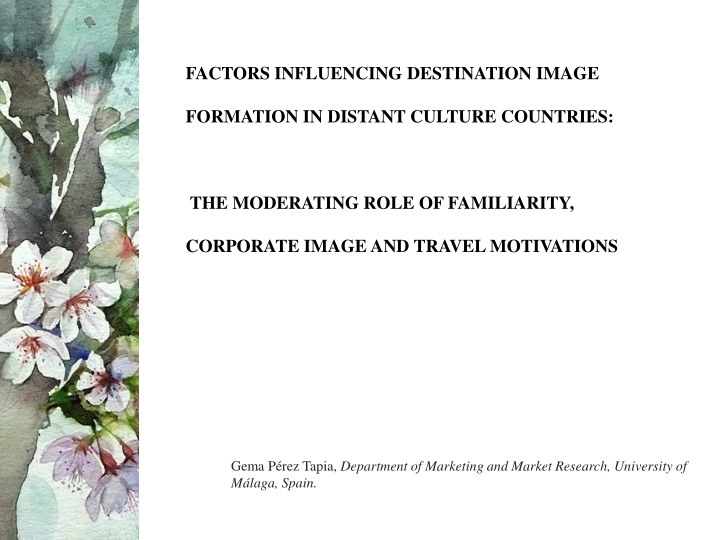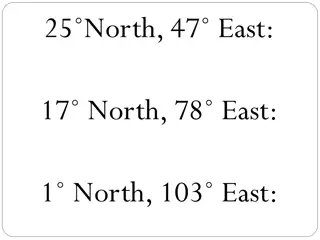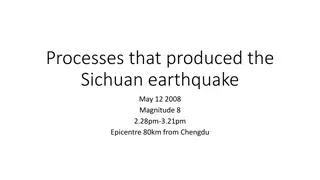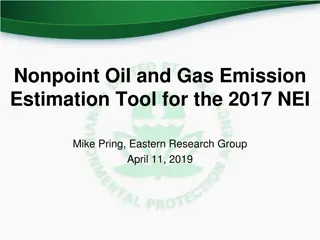
Influencing Factors in Destination Image Formation and its Moderating Role
Explore the factors influencing destination image formation in distant culture countries, with a focus on familiarity, corporate image, and travel motivations. This study aims to validate a model explaining how these factors shape perceptions of tourist destinations.
Download Presentation

Please find below an Image/Link to download the presentation.
The content on the website is provided AS IS for your information and personal use only. It may not be sold, licensed, or shared on other websites without obtaining consent from the author. If you encounter any issues during the download, it is possible that the publisher has removed the file from their server.
You are allowed to download the files provided on this website for personal or commercial use, subject to the condition that they are used lawfully. All files are the property of their respective owners.
The content on the website is provided AS IS for your information and personal use only. It may not be sold, licensed, or shared on other websites without obtaining consent from the author.
E N D
Presentation Transcript
FACTORS INFLUENCING DESTINATION IMAGE FORMATION IN DISTANT CULTURE COUNTRIES: THE MODERATING ROLE OF FAMILIARITY, CORPORATE IMAGE AND TRAVEL MOTIVATIONS Gema P rez Tapia, Department of Marketing and Market Research, University of M laga, Spain.
ABSTRACT The present research aims to explain more deeply the Theory of the Image of Tourist Destination and its process of formation, specifically regarding the factors that influence the above-mentioned process. This work tries to develop and empirically validate a model which explains the main factors that influence the image of a tourist destination and its process of formation. Based on a literature review, this will involve analysing the relationship between the different factors of the perceived image. These include the familiarity, the corporate image and the motivation of potential tourists.
INTRODUCTION - - Estrategic sector. Economic and employment benefits Responsible for the transmition of social and cultural attitudes. Tourist industry - High level of competition In order to compete in this sector Most studies show the importance of creating a strong, positive, and recognizable image to achieve a COMPETITIVE ADVANTAGE. DESTINATION IMAGE
INTRODUCTION A destination image is important not only due to its influence at the stage of choosing the destination (Goodrich, 1978; Bign , S nchez, & S nchez, 2001) but also in the level of satisfaction (O Leary & Deegan, 2005; Pikkemaat, 2004), loyalty (San Mart n & Del Bosque, 2008), and future behaviour (Campo, Garau, & Martinez, 2010; Chen & Tsai, 2007; Lee, Lee, & Lee, 2005). Image Image perceived perceived of of tourist tourist destination destination
INTRODUCTION The aim of this paper is to develop and empirically validate a model which explains the main factors that influence the image of a tourist destination and its process of formation in distant culture countries Travel motivations DISTANT CULTURE COUNTRIES Corporate Image Level of familiarity
THEORETICAL FRAMEWORK Hypothetical model of the relationship between familiarity, corporate image, travel motivation and cognitive/affective destination image. H2a FAMILIARITY COGNITIVE IMAGE H3a H2b CORPORATE IMAGE H1 H3b H4a AFFECTIVE IMAGE MOTIVATION H4b
THEORETICAL FRAMEWORK Destination Image Personal Factors: Stimulus factors: DESTINATION IMAGE: Psychological (values, motivations, personality) Information sources Previous experience -Social(age, education...) Baloglu and McCleary (1999)
THEORETICAL FRAMEWORK Destination image. Moutinho (1987) defines the tourist destination image as the subjective interpretation of the reality generated by the tourist, establishing the bases for later studies (Baloglu, 2001; Baloglu and Brinberg, 1997; Baloglu and Love, 2005; Baloglu and McCleary, 1999; Beerli and Mart n, 2004a, 2004b; Bign et al., 2001; MacKay and Fesenmaier, 1997; San Mart n and Rodr guez, 2008). The cognitive evaluations referring to the beliefs and personal knowledge about the object. These studies tend to consider image as a concept formed by The affective approximation relating to the individual feelings towards the object. H1: Cognitive and affective images are positively related
THEORETICAL FRAMEWORK Informational (sources of information consulted by the tourist) Familiarity as a multidimensional concept Kim and Richardson (2003) Experiential (visits to the destination) Beerli and Martin (2004) also found that such experience has a positive and significant relationship with the cognitive and affective dimensions between first-time and repeat tourists. H2a: Level of familiarity will have a positive effect on the cognitive image of destination in distant culture countries. H2b: Level of familiarity will have a positive effect on the affective image of destination in distant culture countries.
THEORETICAL FRAMEWORK Corporate image A recent group of authors presents the corporate image as perceptions, (mental) pictures or impressions of an organization that reside in the public s mind (Gr nroos, 1984; Jonhson and Zinkhan, 1990; Balmer, 1995; Gray and Balmer, 1998; Balmer and Gray, 2000; Gotsi and Wilson, 2001; Balmer and Greyser, 2002). H3a: The more positive the corporate image in It might be interesting to know if this variable influence the image and how strong is that relationship a distant destination is, the more positive the cognitive image will be as a tourist destination. H3b: The more positive the corporate image in a distant destination is, the more positive the affective image will be as a tourist destination.
THEORETICAL FRAMEWORK Travel motivations Travel motivations can be considered as one of the most important psychological influences (destination s election). Motivations are the inner state of a person or certain needs of a person, which forces them to act in a specific way to satisfied it. of tourist behavior Those destinations that have a stronger image of agreement with the motivations of the potential tourist, will have major possibilities of being chosen. H4a: Travel Motivations will have a positive effect on the cognitive image of destination in distant culture countries. H4b: Travel Motivations will have a positive effect on the affective image of destination in distant culture countries.
THEORETICAL FRAMEWORK Decision making process (Singhapakdi et al., 1994; Swaidan & Hayes, 2005); Sensitivity to ethical problems (Swaidan & Hayes, 2005); Trade (Heide, 1994); Distant destinations Consumer behaviour (Dawar et al., 1996; De Mooij & Hofstede, 2002); Human resource practices (Aycan et al., 2000)
RESEARCH METHODS Survey methods were used to collect data. Major variables in the questionnaire are: Destination images (affective/cognitive). Familiarity. Corporate image. Travel motivations.
RESEARCH METHODS Destination Image Familiarity Corporate Image Travel Motivations The cognitive Experiential The corporate Travel motivations dimension of Spain familiarity was image measures up was measured image was measured by visits across a structured following Baloglu measured through to the destination methodology, there and McCleary items from Baloglu (previously being included in (1999a) and San and McCleary visited/not the questionnaire Mart n and (1999). for the previously visited), the corporate Rodriguez (2008) affective whereas attributes of image establishing 14 dimension, four informational that stem from a items related to bipolar items on a familiarity was review of the wide travel motivations five-point semantic measured using the and recent differential scale number of literature (Capriotti, were used (Baloglu information 2013). and McCleary sources consulted 1999). by the tourist.
RESPONDENT PROFILE The sample was composed of 307 Korean citizens. and in order to facilitate their comprehension, it was translated into Korean. Asia is one of the most important outbound tourist markets in the world.
RESPONDENT PROFILE With regard to specific characteristics, 52.1% were male while 47.9% were female. 49.2% of those surveyed fell into the age bracket of 18 to 24; 29% fell into the bracket of 25 to 44; the remaining 21.8% of those surveyed were over 45. Among those surveyed, the overwhelming majority already have or will soon have a university degree (94.1%); 60.3% were single; and 44.6% were engaged in active employment, while 54.4% were students.
RESPONDENT PROFILE The study has not been finished yet. In any case, for its analysis it is going to be used the Structural Equation Modeling PLS method technique and the of estimation to test the proposed research model, using the statistical software package Advances Analysis for Composites (ADANCO).
POSSIBLE CONTRIBUTIONS OF THE STUDY. From an academic point of view, this research would attempt to provide a conceptual framework that permits continued advances in the development of destination image in order to allow a greater understanding of the process of destination image formation. From a managerial point of view, the results of this work emphasize a set of managerial implications concerning the promotion and communication of the tourist destinations as well as of their companies.
LIMITATIONS. These results must be given some limitations. The main limitation arises from the difficulty of access to a widely representative sample of citizens from distant culture countries. A more heterogeneous sample would contribute to a further generalization of the results
REFERENCES. Baloglu, S. (2001). Image variations of Turkey by familiarity index: informational and experiential dimensions. Tourism Management, 22(2), 127-133. Baloglu, S., & McCleary, K. W. (1999). A model of destination image formation. Annals of tourism research, 26(4), 868-897. Beerli, A., & Martin, J. D. (2004). Factors influencing destination image. Annals of tourism research, 31(3), 657-681. Capriotti, P. (2013). Branding corporativo. LA COMUNICACI N DE LAS MARCAS, 47. Echtner, C. M., & Ritchie, J. B. (1993). The measurement of destination image: An empirical assessment. Journal of travel research, 31(4), 3-13. Guti rrez, H. S. M., & del Bosque, I. R. (2010). Los factores est mulo y personales como determinantes de la formaci n de la imagen de marca de los destinos tur sticos: un estudio aplicado a los turistas que visitan un destino vacacional. Cuadernos de Econom a y Direcci n de la Empresa, 13(43), 37-63. Moutinho, L. (1987). Consumer behaviour in tourism. European journal of marketing, 21(10), 5-44. You, X., O'leary, J., Morrison, A., & Hong, G. S. (2000). A cross-cultural comparison of travel push and pull factors: United Kingdom vs. Japan. International Journal of Hospitality & Tourism Administration, 1(2), 1-26.
Thank you Muchas gracias!
Hombre: 52,1 % Trabajador en activo: 44,6% Sexo Mujer: 47,9% Estudiante: 54,4% Ocupaci n Amo/a de casa: 0,3% 18- 24 a os: 49,2% Parado/a: 0,7% 25- 44 a os: 29% Edad 45- 64 a os: 20,8% 1 persona: 6,2% M s de 65 a os: 0,3% 2 personas: 5,9% N mero de NS/NC: 0,7% 3 personas: 12,7% miembros de la 4 personas: 45,6% Sin estudios: 1,6% 5 personas: 19,2% familia Primarios/Secundarios: 2,6% 6 personas o m s: 2,6% Nivel educativo Universitarios: 94,1% NS/NC: 7,8% Otros: 1,3% NS/NC: 0,3% De 0 a 890.000 won: 17,6% De 891.000 a 1.780.000 won: 13,7% Soltero/a: 60,3% De 1.781.000 a 2.670.000 won: Casado/a: 35,8% Ingresos 16,9% Viviendo en pareja: 1,3% De 2.671.000 a 3.560.000 won: mensuales Estado civil Separado/a: 0,7% 20,2% Divorciado/a: 0,7% M s de 4.450.000 won: 15% Viudo/a: 0,3% Otros ingresos: 2,6% NS/NC: 1% NS/NC: 14%






